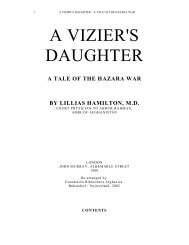The Inquiry into the History of the Hazara Mongols of ... - Hazara.net
The Inquiry into the History of the Hazara Mongols of ... - Hazara.net
The Inquiry into the History of the Hazara Mongols of ... - Hazara.net
Create successful ePaper yourself
Turn your PDF publications into a flip-book with our unique Google optimized e-Paper software.
238<br />
SOUTHWESTERN JOURNAL OF ANTHROPOLOGY<br />
ters for Mongol troops in <strong>the</strong> province.44 Herat and <strong>the</strong> lands running eastward<br />
were ruled by <strong>the</strong> Tajik dynasty <strong>of</strong> Kert, whose vassalage to <strong>the</strong> Mongol Ilkhans<br />
was <strong>of</strong>ten only nominal.45 To <strong>the</strong> south, Sistan was under <strong>the</strong> control <strong>of</strong> <strong>the</strong><br />
independent Nikudari, who appear to have been a mixture <strong>of</strong> <strong>Mongols</strong> and<br />
Tajiks, who used Sistan as a base for <strong>the</strong>ir brigand raids.<br />
But if <strong>the</strong> descendants <strong>of</strong> Hulagu were not interested in what is now central<br />
Afghanistan, <strong>Mongols</strong> centered to <strong>the</strong> north <strong>of</strong> <strong>the</strong> Oxus were. On <strong>the</strong> death<br />
<strong>of</strong> Chinggis Khan, <strong>the</strong> steppe country north <strong>of</strong> <strong>the</strong> Oxus had been given in<br />
appanage to his son Chagatai. Chagataians made raids <strong>into</strong> Khorasan whenever<br />
<strong>the</strong> control <strong>of</strong> <strong>the</strong> Ilkhanate armies was weak. Far<strong>the</strong>r east, where <strong>the</strong>re<br />
was little resistance, <strong>the</strong> Chagataians crossed <strong>the</strong> Hindu Kush at frequent intervals<br />
in <strong>the</strong> hope <strong>of</strong> gaining for <strong>the</strong>mselves <strong>the</strong> riches <strong>of</strong> Hindustan. During <strong>the</strong><br />
twenty-four years between 1282 and 1306 no less than nine major expeditions<br />
crossed <strong>the</strong> Indus.46 Although <strong>the</strong>y were unsuccessful in establishing a foothold<br />
in India, <strong>the</strong> Chagataians did gain control over <strong>the</strong> route to <strong>the</strong> Indus, and in<br />
<strong>the</strong> last decade <strong>of</strong> <strong>the</strong> thirteenth century Doua, <strong>the</strong> Chagataian governor <strong>of</strong><br />
Transoxiana, granted in appanage to his son Coutlouc Khodja <strong>the</strong> countries <strong>of</strong><br />
Ghazni, Sistan, Balkh, and Badakshan, toge<strong>the</strong>r with an army <strong>of</strong> five toumens<br />
(50,000 men). Coutlouc Khodja made his winter quarters in Ghazni, his summer<br />
quarters in Ghur and Gharjistan.47 This places Chagataian <strong>Mongols</strong> well within<br />
<strong>the</strong> lands <strong>of</strong> <strong>the</strong> modem <strong>Hazara</strong>jat.<br />
Daud Khodja, son <strong>of</strong> Coutlouc Khodja, inherited his fa<strong>the</strong>r's appanage early<br />
in <strong>the</strong> fourteenth century, but was forced north <strong>of</strong> <strong>the</strong> Oxus by an army <strong>of</strong><br />
Uljaitu, Ilkhan <strong>of</strong> Iran (ruled 1305-1316 AD). Uljaitu, however, granted <strong>the</strong><br />
country between Balkh and Kabul, Badakhshan and Kandahar, in appanage to<br />
Yassavour, a Chagataian leader who had transferred his allegiance to Uljaitu.48<br />
When Yassavour sought to become independent <strong>of</strong> <strong>the</strong> Ilkhanate as well as <strong>of</strong><br />
<strong>the</strong> Chagataian Khan, armies from both Transoxiana and Iran were sent against<br />
him at Kandahar. Yassavour was killed, but his considerable following was apparently<br />
allowed to remain when <strong>the</strong> invading armies retired. Although <strong>the</strong> combined<br />
armies are said to have numbered 40,000 men, <strong>the</strong>ir leaders chose to buy <strong>of</strong>f<br />
Yassavour's generals ra<strong>the</strong>r than undertake a military engagement.49 This sug-<br />
44 Idem, vol. 4, pp. 4, 121, 564-565, 605, 670, 674.<br />
45 Idem, vol. 4, p. 181.<br />
46 d'Ohsson, vol. 4, pp. 559-562.<br />
47 Idem, vol. 4, pp. 268-269.<br />
48 Idem, vol. 4, pp. 562, 568.<br />
49 Idem, vol. 4, pp. 642-644.



